warning lights SAAB 9-3 2002 Owners Manual
[x] Cancel search | Manufacturer: SAAB, Model Year: 2002, Model line: 9-3, Model: SAAB 9-3 2002Pages: 256, PDF Size: 11.55 MB
Page 3 of 256
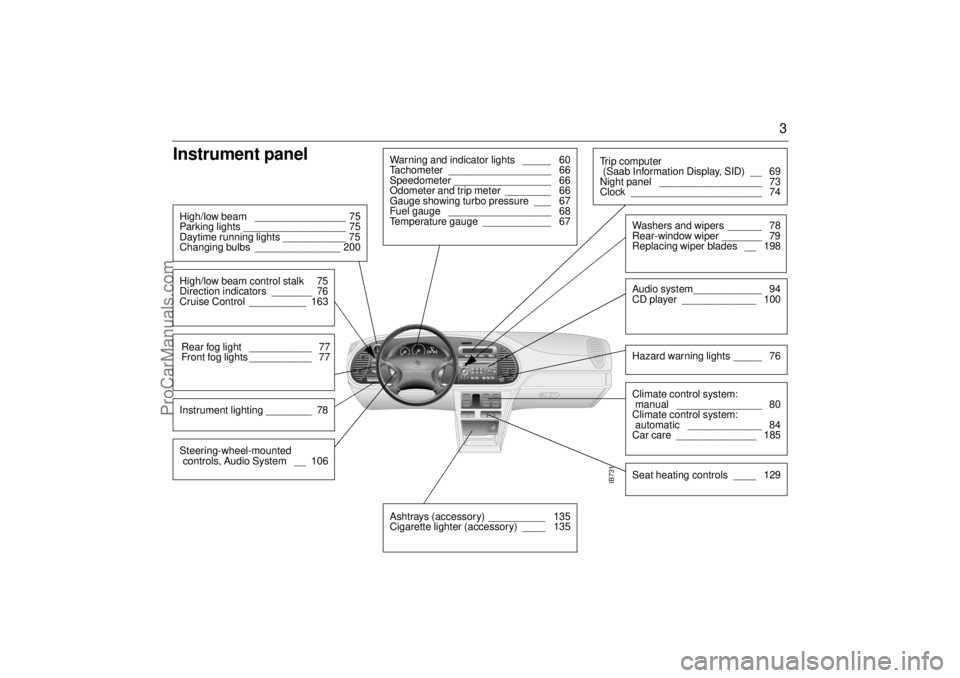
3
Instrument panel High/low beam ________________ 75
Parking lights __________________ 75
Daytime running lights ___________ 75
Changing bulbs _______________ 200High/low beam control stalk 75
Direction indicators _______ 76
Cruise Control __________ 163Rear fog light ___________ 77
Front fog lights ___________ 77Instrument lighting ________ 78
Warning and indicator lights _____ 60
Tachometer __________________ 66
Speedometer _________________ 66
Odometer and trip meter ________ 66
Gauge showing turbo pressure ___ 67
Fuel gauge __________________ 68
Temperature gauge ____________ 67
IB731
Ashtrays (accessory) __________ 135
Cigarette lighter (accessory) ____ 135
Tr i p c o m p u t e r
(Saab Information Display, SID) __ 69
Night panel __________________ 73
Clock _______________________ 74
Washers and wipers ______ 78
Rear-window wiper _______ 79
Replacing wiper blades __ 198Audio system____________ 94
CD player _____________ 100Hazard warning lights _____ 76Climate control system:
manual _______________ 80
Climate control system:
automatic _____________ 84
Car care ______________ 185Seat heating controls ____ 129
Steering-wheel-mounted
controls, Audio System __ 106
ProCarManuals.com
Page 37 of 256
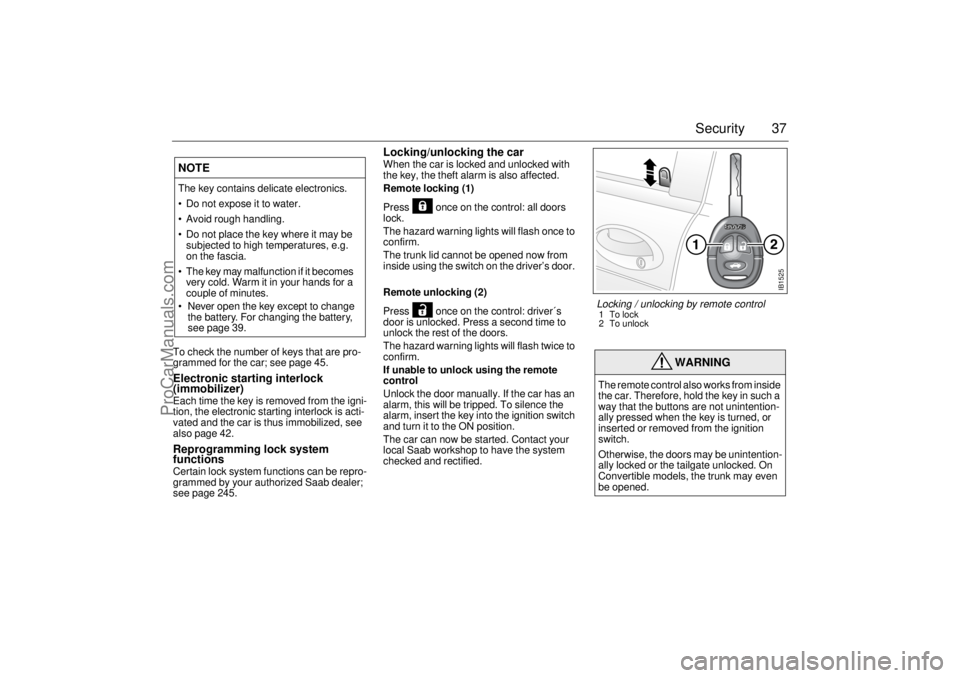
37 Security
To check the number of keys that are pro-
grammed for the car; see page 45.Electronic starting interlock
(immobilizer)Each time the key is removed from the igni-
tion, the electronic starting interlock is acti-
vated and the car is thus immobilized, see
also page 42. Reprogramming lock system
functionsCertain lock system functions can be repro-
grammed by your authorized Saab dealer;
see page 245.
Locking/unlocking the carWhen the car is locked and unlocked with
the key, the theft alarm is also affected.
Remote locking (1)
Press once on the control: all doors
lock.
The hazard warning lights will flash once to
confirm.
The trunk lid cannot be opened now from
inside using the switch on the driver’s door.
Remote unlocking (2)
Press once on the control: driver´s
door is unlocked. Press a second time to
unlock the rest of the doors.
The hazard warning lights will flash twice to
confirm.
If unable to unlock using the remote
control
Unlock the door manually. If the car has an
alarm, this will be tripped. To silence the
alarm, insert the key into the ignition switch
and turn it to the ON position.
The car can now be started. Contact your
local Saab workshop to have the system
checked and rectified.
NOTEThe key contains delicate electronics.
Do not expose it to water.
Avoid rough handling.
Do not place the key where it may be
subjected to high temperatures, e.g.
on the fascia.
The key may malfunction if it becomes
very cold. Warm it in your hands for a
couple of minutes.
Never open the key except to change
the battery. For changing the battery,
see page 39.
WARNING
The remote control also works from inside
the car. Therefore, hold the key in such a
way that the buttons are not unintention-
ally pressed when the key is turned, or
inserted or removed from the ignition
switch.
Otherwise, the doors may be unintention-
ally locked or the tailgate unlocked. On
Convertible models, the trunk may even
be opened.
IB1525
Locking / unlocking by remote control 1To lock
2 To unlock
ProCarManuals.com
Page 43 of 256

43 Security
Alarm signals When the car alarm is armed, it will be trig-
gered if any door, the trunk lid or hood, is
opened, or if a window is broken.
The alarm will also be triggered if an attempt
is made to bypass or short-circuit the igni-
tion switch, or to disconnect the battery.
If the alarm is triggered, the following alarm
signals will be set off:
Flashing of hazard warning lights for five
minutes.
Siren wailing for 30 seconds.
The alarm signals will stop if the alarm is
deactivated (car unlocked) during the alarm
period.
Panic-functionIn the car alarm system is a function called
"Panic-function".
To activate panic function:
Push and hold one of the buttons on the
key for 2 seconds, or if you are sitting
inside the car...
Push the LOCK-switch on the center con-
sole for 2 seconds (not Convertibles).
These actions will trigger the alarm (hazard
warning lights and siren).
To deactivate panic function:
Push one of the buttons on the key.
Push the LOCK-switch in the center con-
sole.
Turn the key in one of the doors or
Turn the ignition to ON.
When the panic-function is activated the car
will be locked/unlocked depending upon
which button was pushed.
When the ignition is ON the panic-function
cannot be activated.
NOTE It is possible to inadvertently deacti-
vate the car alarm and at the same
time unlock the car, if the button on the
key is pressed by mistake when the
car is still within its range.
When locking the car by remote con-
trol in extremely cold weather, it is
advisable to check that the lock
system has operated properly. To do
so, check that the interior locking but-
tons are all down.
If not, unlock and relock the car again.
ProCarManuals.com
Page 44 of 256

44 SecurityOverview of functions
Alarm signals may differ between model variants for different coun-
tries.
Some of the car alarm functions can be reprogrammed – con-
sult your Saab dealer for further details (see page 245). Locking/
activation Hazard warning lights flash once (0.5 seconds).
Horn chirps once.
The LED will come on for 10 seconds.
Unlocking/
deactivation Hazard warning lights flash twice.
Horn chirps twice.
The LED will come on for two seconds.
Unlocking/
deactivation of
trunk lid alarm Hazard warning lights flash three times.
Horn chirps three times.
The LED will flash three times per second for
10 seconds.
Alarm triggered Hazard warning lights flash for 5 min.
Siren wails for 30 seconds.
To switch off the alarm, deactivate the system in
the normal way (unlocking) by unlocking the
door with the key or the remote
Window-glass
sensor The sensor detects if any window is broken and
triggers the alarm.
To disable the sensor, see page 42.
Key The range of the key is normally 5-10 yds.
(5-10 metres), although it can be substantially
more than this in ideal conditions.
If the key is not working, it may be because the
code signal has not been synchronized with that
in the control module for the car alarm. To rectify
this, press the unlock button on the key at least
four times in quick succession. When it is recog-
nized, the door locks will cycle.
If a key is lost, the new one will have to be pro-
grammed (all keys must be present) to match the
car’s unique security code. Get in touch with an
authorized Saab dealer. Battery for key The battery for the key will normally have a life of
4 years. When the battery needs changing,
”REPLACE KEY BATTERY” will appear on the
SID.
Contact a Saab workshop to have the battery
changed.
Car-battery
voltage If the battery is disconnected while the alarm is
active (car is locked), for example during an
attempt to steal the car, the alarm will be trig-
gered.
ProCarManuals.com
Page 59 of 256
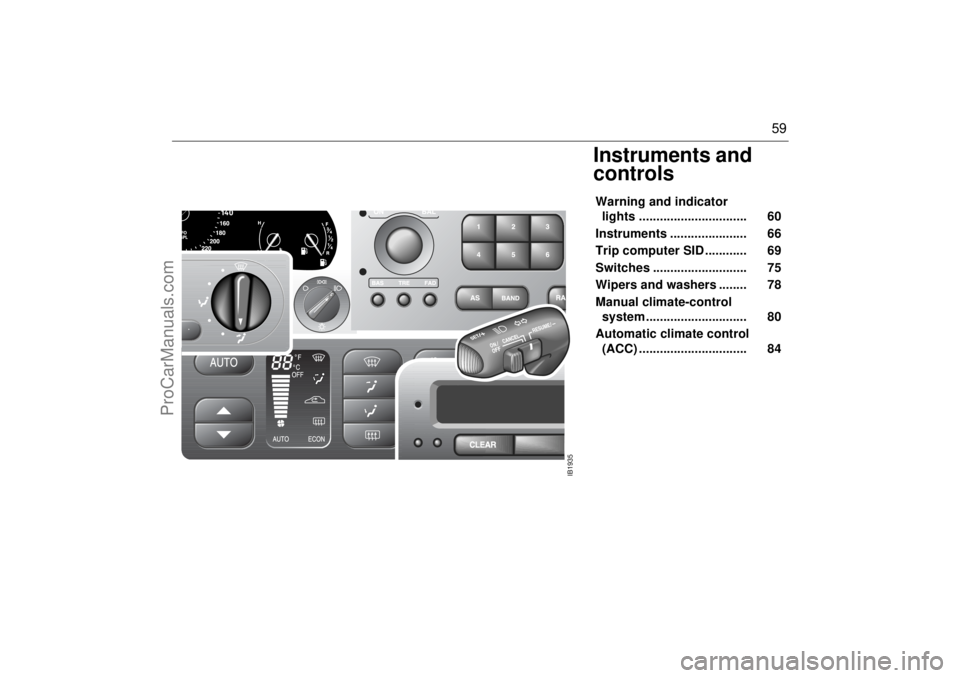
59
Instruments and
controlsWarning and indicator
lights ............................... 60
Instruments ...................... 66
Trip computer SID ............ 69
Switches ........................... 75
Wipers and washers ........ 78
Manual climate-control
system ............................. 80
Automatic climate control
(ACC) ............................... 84
IB1935
ProCarManuals.com
Page 60 of 256
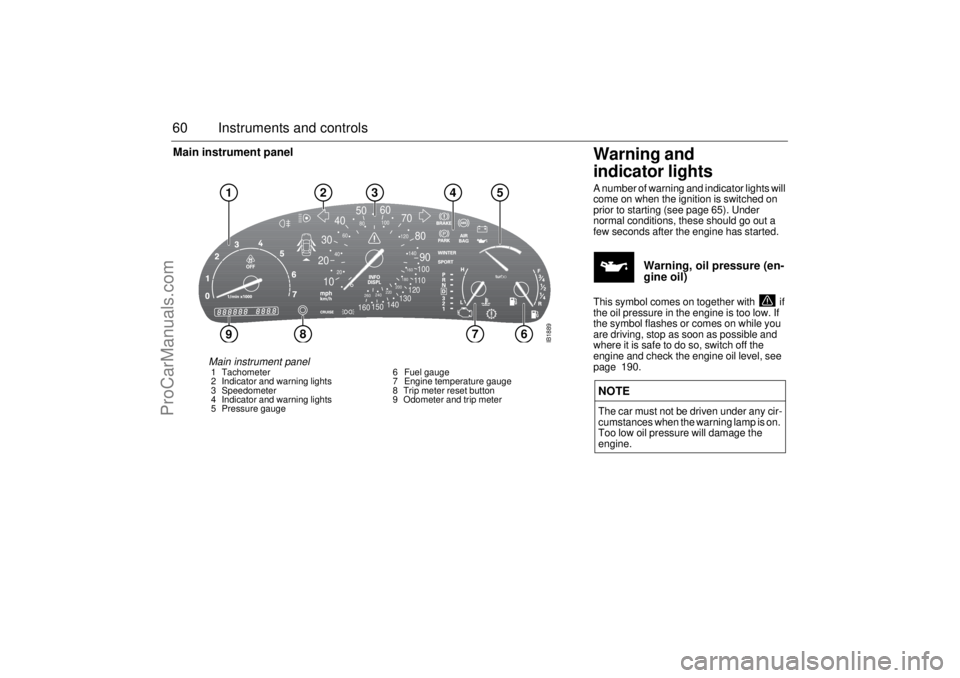
60 Instruments and controlsMain instrument panel
Warning and
indicator lightsA number of warning and indicator lights will
come on when the ignition is switched on
prior to starting (see page 65). Under
normal conditions, these should go out a
few seconds after the engine has started.
Warning, oil pressure (en-
gine oil)
This symbol comes on together with if
the oil pressure in the engine is too low. If
the symbol flashes or comes on while you
are driving, stop as soon as possible and
where it is safe to do so, switch off the
engine and check the engine oil level, see
page 190. NOTEThe car must not be driven under any cir-
cumstances when the warning lamp is on.
Too low oil pressure will damage the
engine.
2030405060
70
80
90
100
11 0
120
130
140
150
160
240
260220200180160
140 120 100
80
60
40
20
10
IB1889
9
4
5
3
2
8
6
1
7
Main instrument panel 1 Tachometer
2 Indicator and warning lights
3 Speedometer
4 Indicator and warning lights
5 Pressure gauge6 Fuel gauge
7 Engine temperature gauge
8 Trip meter reset button
9 Odometer and trip meter
ProCarManuals.com
Page 61 of 256
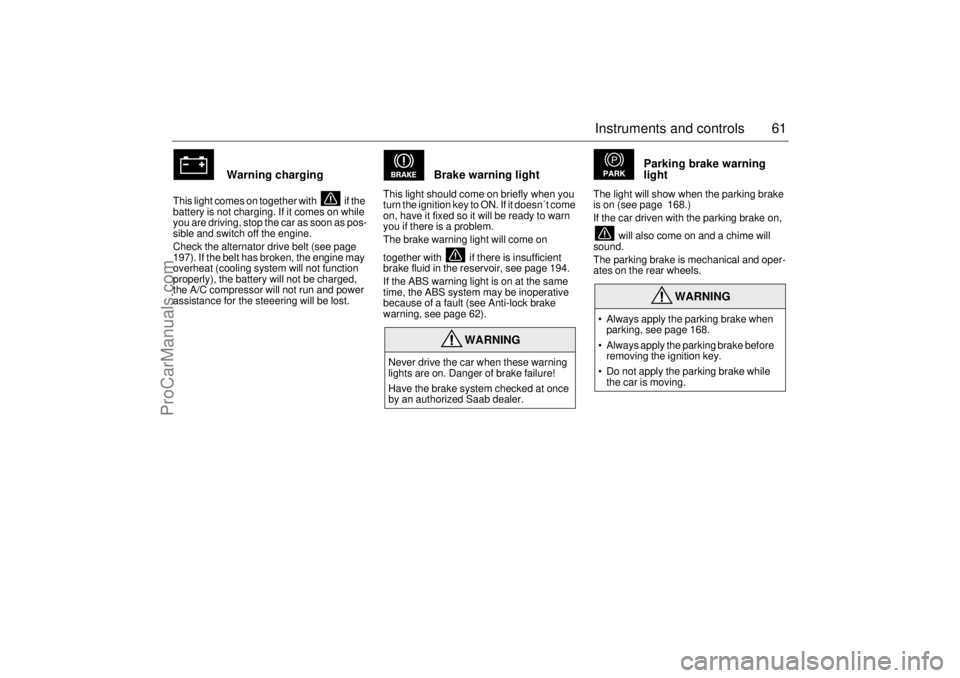
61 Instruments and controls
Warning charging
This light comes on together with if the
battery is not charging. If it comes on while
you are driving, stop the car as soon as pos-
sible and switch off the engine.
Check the alternator drive belt (see page
197). If the belt has broken, the engine may
overheat (cooling system will not function
properly), the battery will not be charged,
the A/C compressor will not run and power
assistance for the steeering will be lost.
Brake warning light
This light should come on briefly when you
turn the ignition key to ON. If it doesn´t come
on, have it fixed so it will be ready to warn
you if there is a problem.
The brake warning light will come on
together with if there is insufficient
brake fluid in the reservoir, see page 194.
If the ABS warning light is on at the same
time, the ABS system may be inoperative
because of a fault (see Anti-lock brake
warning, see page 62).
Parking brake warning
light
The light will show when the parking brake
is on (see page 168.)
If the car driven with the parking brake on,
will also come on and a chime will
sound.
The parking brake is mechanical and oper-
ates on the rear wheels.
WARNING
Never drive the car when these warning
lights are on. Danger of brake failure!
Have the brake system checked at once
by an authorized Saab dealer.
WARNING
Always apply the parking brake when
parking, see page 168.
Always apply the parking brake before
removing the ignition key.
Do not apply the parking brake while
the car is moving.
ProCarManuals.com
Page 65 of 256
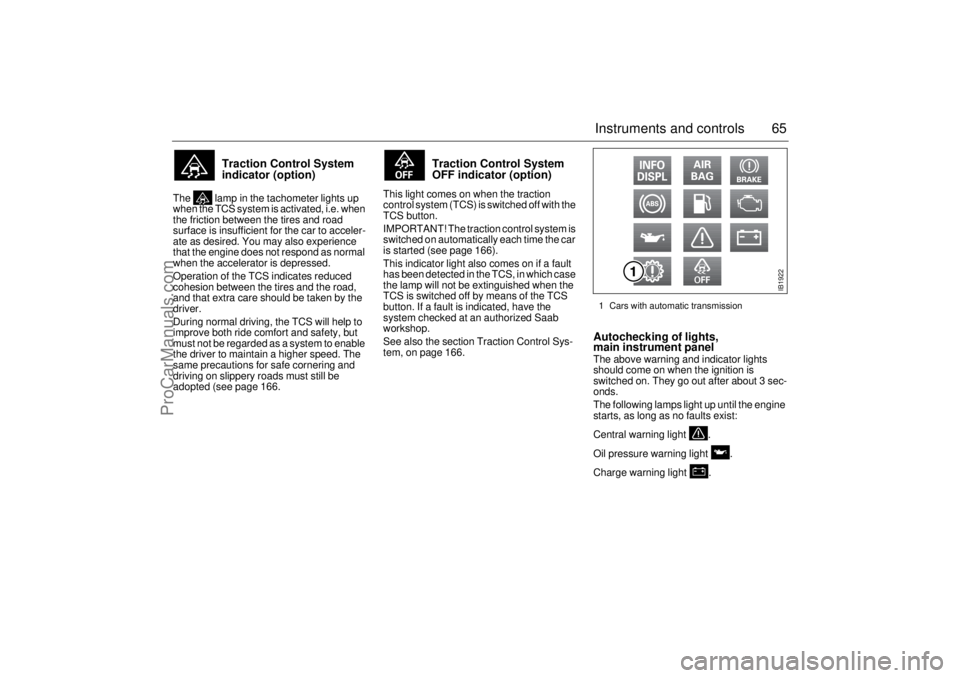
65 Instruments and controls
Traction Control System
indicator (option)
The lamp in the tachometer lights up
when the TCS system is activated, i.e. when
the friction between the tires and road
surface is insufficient for the car to acceler-
ate as desired. You may also experience
that the engine does not respond as normal
when the accelerator is depressed.
Operation of the TCS indicates reduced
cohesion between the tires and the road,
and that extra care should be taken by the
driver.
During normal driving, the TCS will help to
improve both ride comfort and safety, but
must not be regarded as a system to enable
the driver to maintain a higher speed. The
same precautions for safe cornering and
driving on slippery roads must still be
adopted (see page 166.
Traction Control System
OFF indicator (option)
This light comes on when the traction
control system (TCS) is switched off with the
TCS button.
IMPORTANT! The traction control system is
switched on automatically each time the car
is started (see page 166).
This indicator light also comes on if a fault
has been detected in the TCS, in which case
the lamp will not be extinguished when the
TCS is switched off by means of the TCS
button. If a fault is indicated, have the
system checked at an authorized Saab
workshop.
See also the section Traction Control Sys-
tem, on page 166.
Autochecking of lights,
main instrument panel The above warning and indicator lights
should come on when the ignition is
switched on. They go out after about 3 sec-
onds.
The following lamps light up until the engine
starts, as long as no faults exist:
Central warning light .
Oil pressure warning light .
Charge warning light .
IB1922
1 Cars with automatic transmission
ProCarManuals.com
Page 73 of 256

73 Instruments and controls
The following CHECK messages may be
displayed: 1) This message will be displayed approximately
600 miles (1,000 km) before the next sched-
uled service is due, or when 365 days have
elapsed since the last service. The message
should be cleared at the time of that service
(see the Saab Warranties & Service Record
Booklet).
This message can also be deleted by first
briefly pressing the CLR button, then depress-
ing it a second time for at least eight seconds
until "SERVICE" appears on the display and a
chime sounds. The message can only be
deleted when it is shown on the SID.
Night panelTo improve night-driving conditions inside
the car, the Night Panel mode can be
selected. In this mode, the amount of infor-
mation displayed is reduced, and only the
most important instruments and displays
will be illuminated.
When the Night Panel button is pressed,
only the speedometer will be illuminated (up
to the 87-mph or 140-km/h graduation), all
the other instruments illumination will be
extinguished and their needles moved to
zero. Both the SID and the ACC displays will
be extinguished and the backlighting for
switches and other controls will be dimmed.
Note: All indicator and warning lights,
together with the display of CHECK mes-
sages, will operate as normal. The following conditions will wake up the
respective displays in the Night-Panel
mode:
Setting of the Audio System, SID or ACC
(display comes on for ten seconds).
CHECK message generated in the SID.
High engine revs cause the rev counter to
be illuminated until the engine speed has
fallen again.
If the quantity of fuel remaining falls below
4 gallons (15 liters), the fuel gauge will be
illuminated.
If the engine temperature rises above nor-
mal, the temperature gauge will be illumi-
nated.
If the speed of the car exceeds 84 mph
(135 km/h), the entire speedometer will
be illuminated.
In cars with automatic transmission, if the
selector lever is moved from D to position
3, 2 or 1, the selector indication on the
main instrument panel will be illuminated.
To restore the displays and lighting to the
normal mode, press the Night-Panel button. Display shows: See
page
BRAKE LIGHT FAILURE 202
FRONT LIGHT FAILURE 200
REAR LIGHT FAILURE 202
FOG LIGHT FAILURE 203
WASHER FLUID LEVEL LOW 199
TIGHTEN FUEL FILLER CAP 151
FILL COOLANT FLUID 192
KEY NOT ACCEPTED 45
REPLACE KEY BATTERY 45
SERVICE THEFT ALARM 45
TRANSMISSION OVERHEATING 159
TIME FOR SERVICE
1)
230
ProCarManuals.com
Page 76 of 256
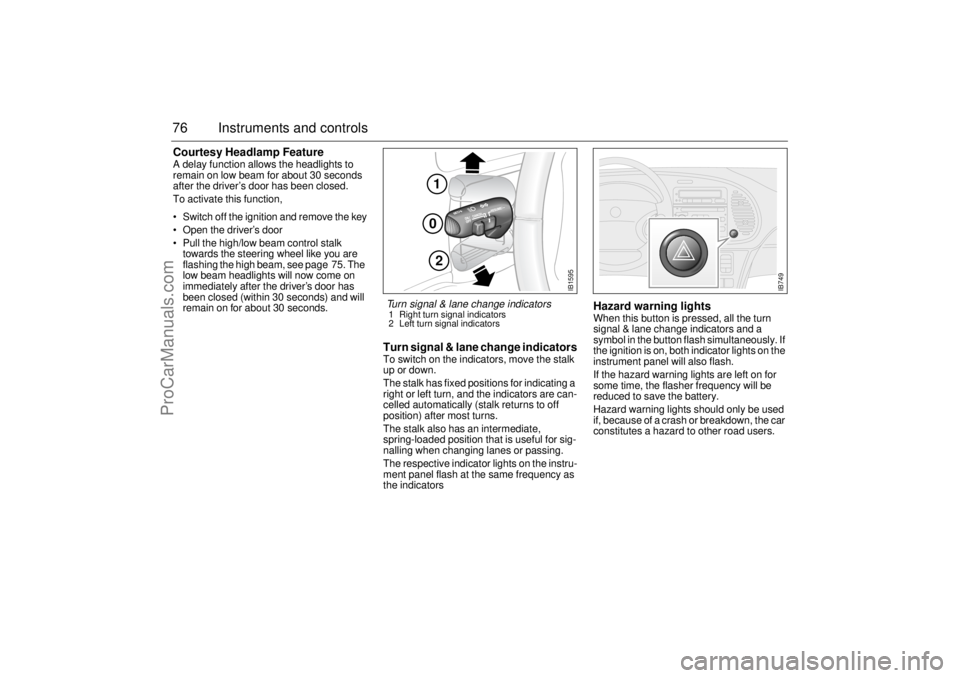
76 Instruments and controlsCourtesy Headlamp Feature A delay function allows the headlights to
remain on low beam for about 30 seconds
after the driver’s door has been closed.
To activate this function,
Switch off the ignition and remove the key
Open the driver’s door
Pull the high/low beam control stalk
towards the steering wheel like you are
flashing the high beam, see page 75. The
low beam headlights will now come on
immediately after the driver’s door has
been closed (within 30 seconds) and will
remain on for about 30 seconds.
Turn signal & lane change indicatorsTo switch on the indicators, move the stalk
up or down.
The stalk has fixed positions for indicating a
right or left turn, and the indicators are can-
celled automatically (stalk returns to off
position) after most turns.
The stalk also has an intermediate,
spring-loaded position that is useful for sig-
nalling when changing lanes or passing.
The respective indicator lights on the instru-
ment panel flash at the same frequency as
the indicators
Hazard warning lightsWhen this button is pressed, all the turn
signal & lane change indicators and a
symbol in the button flash simultaneously. If
the ignition is on, both indicator lights on the
instrument panel will also flash.
If the hazard warning lights are left on for
some time, the flasher frequency will be
reduced to save the battery.
Hazard warning lights should only be used
if, because of a crash or breakdown, the car
constitutes a hazard to other road users.
102
IB1595
Turn signal & lane change indicators 1 Right turn signal indicators
2 Left turn signal indicators
IB749
ProCarManuals.com